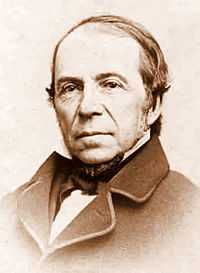Leo Lesquereux

Charles Léo Lesquereux (November 18, 1806 – October 25, 1889) was a Swiss bryologist and a pioneer of American paleobotany. He was born in the town of Fleurier, located in the canton of Neuchâtel.
Due to a childhood accident, Lesquereux suffered from progressive hearing loss that eventually led to total deafness. Despite the fact he lacked formal training in botany, he became a celebrated figure in the field of paleobotany. Until 1827 he took classes at the academy at Neuchâtel, and subsequently worked as a tutor of French language in Eisenach. Afterwards he returned to Switzerland as a schoolteacher, and later principal in the town of Locle. Within three years his hearing had deteriorated to the point he had to give up his teaching job.
As a young man he took many excursions in order to collect mosses in the Jura Mountains, eventually leading to investigations of peat bogs. His pioneer research and analysis on the origin, composition and development of peat resulted in a close friendship with famed scientist Louis Agassiz (1807-1873). Soon afterwards, Lesquereux was commissioned by the Prussian government to perform scientific studies of peat bogs throughout Europe.
In 1847 Lesquereux followed Agassiz to the United States, subsequently traveling to Columbus, Ohio, where he performed bryological research with William Starling Sullivant (1803-1873). With Sullivant, he published two editions of a treatise called Musci Exsiccati Americani (1856, 1865). Another significant work on American bryology of his, was a two volume summary of mosses found in the eastern United States, titled Icones Muscorum (1864).
Based on his past studies of European peat bogs, Lesquereux developed theories on the origin of coal formations. As a consultant for state geological surveys in several U.S. states, he performed pioneer investigations of Paleozoic flora. From these paleobotanical studies, his best work was a study of carboniferous flora of Pennsylvania, titled "Description of the Coal Flora of the Carboniferous Formation in Pennsylvania and throughout the United States" (1879–84). a three-volume publication that became a standard for U.S. carboniferous flora.
The plant genus Lesquerella from the family Brassicaceae and the testate amoeba genus Lesquereusia are named in his honor. Lesquereux died at the age of 82 on October 25, 1889 in Columbus.
References
- American Philosophical Society (biography)
- History of Geology by A. Schmidt (biography)
External links
| Wikisource has original works written by or about: Charles Léo Lesquereux |
|